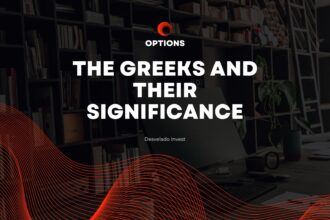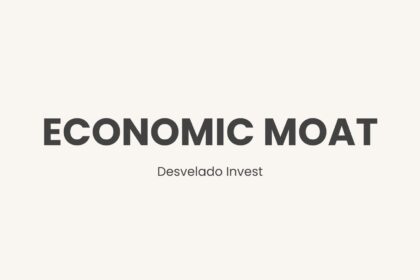Written By: Ansh Jain
Option Greeks are a set of mathematical calculations that help you understand how the price of an options contract can change in response to various factors. By understanding these Greeks, you can make more informed decisions about your options strategies.
Here are the five main option Greeks and their significance, illustrated with examples:
1. Delta (Δ)
Delta is one of the most fundamental “Greeks” in options trading. It measures the sensitivity of an option’s price to changes in the underlying asset’s price. In simpler terms, it tells you how much the option price will change for a Rs 1 change in the underlying asset’s price.
Understanding Delta
- Range: Delta values range from -1 to 1.
- Call Options: Delta ranges from 0 to 1. A higher delta means the option price will move more closely with the underlying asset’s price.
- Put Options: Delta ranges from -1 to 0. A lower delta (closer to -1) means the option price will move more closely with the underlying asset’s price in the opposite direction.
- Interpretation:
- A delta of 0.5 for a call option means that if the underlying stock price increases by Rs 1, the option price will theoretically increase by Rs 0.50.
- A delta of -0.7 for a put option means that if the underlying stock price increases by Rs 1, the option price will theoretically decrease by Rs 0.70.
Real-World Example
Let’s say you’re trading options on HDFC Bank. The current stock price is Rs 1,500. You buy a call option with a strike price of Rs 1,550 and a delta of 0.6.
- If HDFC Bank’s stock price increases by Rs 10 to Rs 1,510, the theoretical change in the option price would be:
- Change in option price = Delta * Change in stock price
- Change in option price = 0.6 * Rs 10 = Rs 6
So, the option price should increase by approximately Rs 6.
Key Points to Remember:
- Delta changes as the underlying stock price and time to expiry change.
- Delta is not a fixed value and is constantly fluctuating.
- Traders use delta to gauge the sensitivity of an option’s price to changes in the underlying asset’s price.
- Delta can also be used for hedging strategies, such as delta hedging, to reduce risk.
2. Gamma (Γ)
Gamma is another crucial Greek in options trading. It measures the rate of change of an option’s delta with respect to changes in the underlying asset’s price. In simpler terms, it tells you how quickly an option’s delta will change as the underlying asset’s price moves.
Understanding Gamma
- Positive Gamma: When an option has a positive gamma, its delta will increase as the underlying asset’s price rises and decrease as the price falls. This means that the option’s price will become more sensitive to price movements in the underlying asset.
- Negative Gamma: Options with negative gamma exhibit the opposite behavior. Their delta decreases as the underlying asset’s price rises and increases as the price falls.
Real-World Example
Let’s continue with our HDFC Bank example. Suppose you have a call option with a delta of 0.6 and a gamma of 0.02. If the stock price increases by Rs 10 to Rs 1,510, the option price will increase by approximately Rs 6, as we calculated earlier.
However, due to the positive gamma, the option’s delta will also increase. This means that the option will become even more sensitive to further price movements. If the stock price continues to rise, the option’s price will increase at an accelerating rate.
Key Points to Remember:
- Gamma is highest when an option is at-the-money (ATM) and lowest when it is deep in-the-money (ITM) or deep out-of-the-money (OTM).
- Gamma is a significant factor to consider when managing option portfolios, especially for options with high gamma.
- Traders often use gamma to their advantage by employing strategies like gamma scalping, which involves buying or selling options to profit from short-term price fluctuations.
3. Vega (ν)
It measures the sensitivity of an option’s price to changes in the implied volatility of the underlying asset. In simpler terms, it tells you how much the option price will change for a 1% change in the implied volatility.
Implied volatility is a metric that estimates how much an asset’s price is expected to fluctuate in the future. It’s a forward-looking measure that reflects investors’ perceptions of risk and uncertainty about an asset’s future movements.
Understanding Vega
- Positive Vega: Both call and put options have positive Vega. This means that as the implied volatility of the underlying asset increases, the value of the option also increases.
- Vega and Time Decay: Vega tends to be higher for options with a longer time to expiration. As time passes, Vega decreases, especially closer to the expiration date.
Real-World Example
Let’s consider a scenario where you’ve bought a call option on a particular stock. The current implied volatility of the stock is 20%. If the market perceives increased uncertainty or expects higher price swings in the future, the implied volatility may rise to 21%.
In this case, the option’s price will increase due to the positive Vega. The exact increase will depend on the specific Vega of the option. If the Vega is 0.05, for instance, the option price will increase by approximately 0.05 * 1 = 0.05 rupees.
Key Points to Remember:
- Vega is highest for at-the-money options and decreases as the option moves further in or out of the money.
- Traders can use Vega to speculate on future volatility movements. If they anticipate increased volatility, they can buy options with high Vega.
- Vega can also be used to hedge against adverse volatility movements. For instance, if a trader is worried about a sudden increase in volatility, they can sell options with high Vega to offset potential losses.
4. Theta (θ)
Theta is an important Greek in options trading. It measures the rate of decline in an option’s price due to the passage of time. In simpler terms, it tells you how much the option’s value will decrease as time passes, all other factors remaining constant.
Understanding Theta
- Negative Theta: All options have negative theta, which means their value decreases over time. This is because as time passes, there are fewer days left for the option to be in-the-money, reducing its potential payoff.
- Theta and Time to Expiration: Theta is highest for options with shorter time to expiration and lowest for options with longer time to expiration.
Real-World Example
Let’s say you’ve bought a call option on Infosys with an expiration date of one month. The current theta of the option is -0.05. This means that, with all other factors remaining constant, the option’s price will decrease by approximately Rs 0.05 per day.
Key Points to Remember:
- Theta is a significant factor to consider for options with shorter time to expiration, as their value decays more rapidly.
- Options sellers (writers) benefit from theta decay, as it increases the value of their positions over time.
- Options buyers, on the other hand, are negatively impacted by theta decay, as it reduces the value of their positions.
5. Rho (ρ)
Rho is a Greek letter used in options trading to measure the sensitivity of an option’s price to changes in the risk-free interest rate. In simpler terms, it tells you how much the option’s price will change for a 1% change in the risk-free interest rate.
The risk-free rate is the theoretical rate of return on an investment with no risk of financial loss. It’s a benchmark used to evaluate other investments by providing a base return that compensates for no risk.
The risk-free rate is typically associated with government securities, like Treasury bonds, which are considered nearly risk-free because of the government’s backing. The yield on a risk-free asset is the minimum rate of return expected on investments with “zero risk”.
Understanding Rho
- Positive Rho: Call options typically have a positive Rho. This means that as interest rates rise, the value of a call option generally increases.
- Negative Rho: Put options typically have a negative Rho. This means that as interest rates rise, the value of a put option generally decreases.
Real-World Example
Let’s consider a scenario where you’ve bought a call option on HDFC Bank. The current risk-free interest rate in India is 6%. If the Reserve Bank of India (RBI) decides to increase the interest rate by 0.25%, the value of your call option will increase, thanks to the positive Rho.
Key Points to Remember:
- Rho is generally a smaller factor compared to other Greeks like Delta, Gamma, Theta, and Vega.
- The impact of interest rate changes on option prices is often less significant than other factors like changes in the underlying asset’s price or implied volatility.
- Rho is more relevant for longer-term options, as the impact of interest rate changes accumulates over time.
Understanding the Greeks provides a foundation for analyzing options, as they help assess the sensitivity of an option’s price to various factors like underlying asset movements, volatility, and time decay. However, to build a complete picture of options trading, it’s crucial to grasp the concept of Put-Call Parity. This relationship connects the pricing of calls and puts with the underlying asset, ensuring fair valuation and presenting arbitrage opportunities when imbalances occur. Together, the Greeks and Put-Call Parity equips you with the tools to manage risk and optimize their strategies in the options market.
Put-Call Parity
Imagine you’re at a fair. There are two booths:
Booth A: You can buy a ticket to win a prize if the price of a specific toy goes up.
Booth B: You can sell a ticket to win a prize if the price of the same toy goes down.
Put-Call Parity is like saying that the price of these two tickets should be related. If one is too expensive compared to the other, you can make a profit by buying the cheaper one and selling the more expensive one.
Put-Call Parity is a fundamental relationship between the prices of European call and put options on the same underlying asset, with the same strike price and expiration date. It states that the price of a call option plus the present value of the strike price equals the price of a put option plus the current price of the underlying asset.
The formula for put-call parity is:
C + PV(X) = P + S
Where:
- C: Price of the call option
- PV(X): Present value of the strike price (X)
- P: Price of the put option
- S: Current price of the underlying asset
What does this mean?
This equation implies that a portfolio consisting of a long call option and a long position in a risk-free bond with a face value equal to the strike price is equivalent to a portfolio consisting of a long put option and a long position in the underlying asset.
Why is it important?
- Arbitrage Opportunities: If the market prices of options deviate from the relationship implied by put-call parity, arbitrage opportunities arise. Arbitrageurs can exploit these mispricing’s to profit without risk.
- Option Pricing Models: Put-call parity is a fundamental assumption in many option pricing models.
- Risk Management: Understanding put-call parity helps traders and investors manage risk effectively by constructing synthetic positions.
Key Points to Remember:
- Put-call parity only applies to European options, which can only be exercised at expiration.
- Real-world factors like transaction costs, taxes, and dividends can cause deviations from put-call parity.
- While arbitrage opportunities can arise from deviations, they are often short-lived and require quick execution.
Keep exploring, learning, and refining your skills – see you next time!






